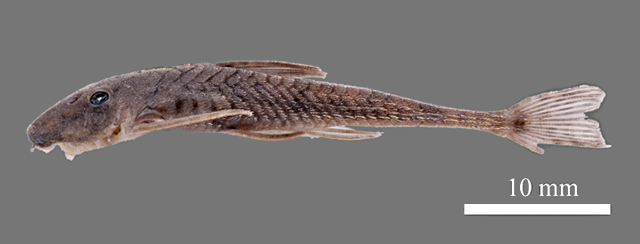| Loricariidae (Armored catfishes), subfamily: Loricariinae |
| 3.467 cm SL (male/unsexed) |
|
demersal; freshwater |
| South America: Known only from type locality, headwaters of Crique Grand Leblond on the Tabular Mountain of Trinité Massif, French Guiana. |
|
Dorsal soft rays (total): 7-7; Anal spines: 1-1; Anal soft rays: 5-5. Distinguished from other congeners by its stocky body shape reminiscent of the crassicauda group, and by its mitochondrial barcode signature typical for the longicauda group (JF292281, JF292284, JF292285). Differs from Harttiella parva plus representatives of the longicauda group except Harttiella pilosa by having a deeper body at dorsal-fin origin (mean = 12.69 ± 0.54% of SL vs 9.86 ± 0.79 < mean < 10.66 ± 0.87% of SL); and from Harttiella janmoli by having a shallower body at dorsal-fin origin (mean = 12.69 ± 0.54% of SL vs 14.80 ± 1.14% of SL). Can be separated from Harttiella pilosa by having a longer head (mean = 26.18 ± 1.12% of SL vs 23.74 ± 1.35% of SL), and from Harttiella crassicauda by having a longer caudal peduncle (mean = 42.35 ± 1.44% of SL vs 36.14 ± 1.66% of SL) (Ref. 90209). |
|
|
Critically Endangered (CR); Date assessed: 14 December 2020 (B2ab(iii)) Ref. (130435)
|
| harmless |
Source and more info: www.fishbase.org. For personal, classroom, and other internal use only. Not for publication.
